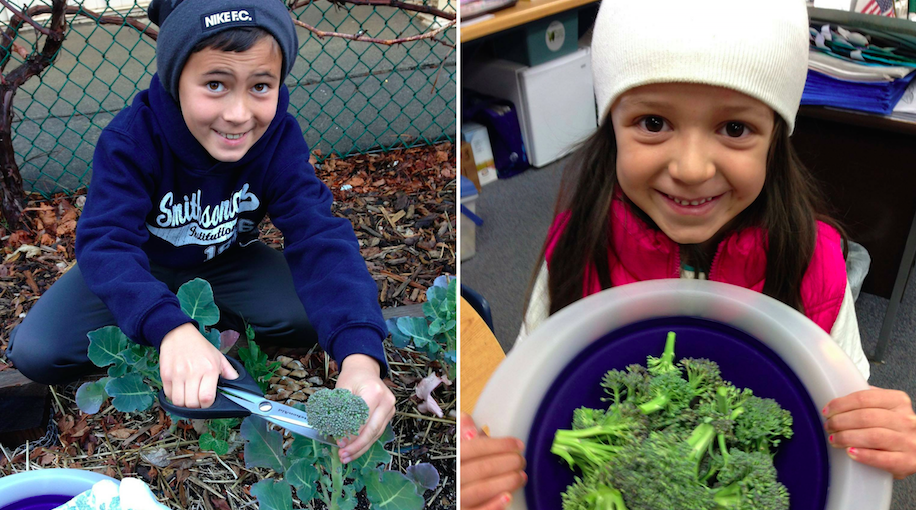By Anna Mullen, Digital Media Associate
“I've seen the effect of farm to school activities in our school and in our community at large. Kids are eating better because the food is better, but the way the community has come together to support it and the various partnerships we've created since receiving the USDA Farm to School Planning Grant have been amazing."
- Susi Jones, Executive Director for Julian Pathways, Julian, Calif.

Chef Jeremy Manely (left) and Julian Pathways students tour “Down the Road” Farm, where local produce is grown for school lunches. (Photos courtesy of Tricia Elisara)
Farm to school at Julian Pathways started with an unused plot of asphalt. Parents were the first to suggest the asphalt be cleared and a school garden planted, and it didn’t take long for students and teachers to follow. The new garden at Julian Pathways became a living laboratory for students, and it sparked efforts to extend nutrition and agriculture education to the lunchroom. Six years later, farm to school at Julian Pathways has become a whole community affair.
As Julian Pathways Executive Director Susi Jones explains, expanding farm to school beyond the garden and into the lunchroom was not an easy task. Without facilities to cook meals or room to build a kitchen, Julian Pathways had served frozen, pre-packaged lunches. “At the time, we felt it was the best option,” she said. “But we also felt our students were getting the bad end of the deal. It was not good food, and we were not nurturing our students.”
Although students were learning about local, fresh food in the garden, they weren’t connecting with healthy eating in the cafeteria. So in 2012, the Julian Union Elementary School District applied for a USDA Farm to School Planning Grant to identify ways to secure local, fresh and delicious meals for their students. Julian Pathways, the student and family support program for the district, coordinates the farm to school program. Alumnus and local chef Jeremy Manley jumped at the opportunity to cater lunches at his alma mater. Jeremy’s on the Campus – a play on his restaurant Jeremy’s on the Hill – pays particular attention to sourcing its food locally and students are gobbling up the fresh fruit and vegetables options.

“January was broccoli month, and I over heard two four-year-old girls say, ‘There’s broccoli in the salad! I love my broccoli raw!’ What kind of four-year-olds talk like this without exposure in the garden?” –Susi Jones, Julian Pathways Executive Director
Students in Club Jaguar's afterschool garden class eat the Harvest of the Month – broccoli – that they planted and tended. (Photo courtesy of Tricia Elisara)
The USDA Farm to School Planning Grant enabled Julian Pathways to explore what farm to school activities best fit their community, and it helped build a creative partnership with a local chef that grew to include local farmers, small businesses and a vibrant sense of community. Their next goal is to plant a large heritage apple orchard that will provide local fruit for students, as well as serve the entire community with jobs, re-invigorating the town’s historic apple industry.
Julian Pathways has done an incredible job supporting these innovative and burgeoning new partnerships, but more must be done to realize their full potential. “We are such a small district, and there’s not a lot of money,” Jones explained. “Our reimbursements are small, and we really are reaching and scrounging for funding.” To grow the program’s infrastructure, Julian Pathways applied for a USDA Farm to School Implementation Grant. But because of such high demand across the country, Julian Pathways was not awarded these funds. Nationally, demand for the USDA Farm to School Grant Program is five times higher than available federal funding.
Julian Pathways’ story exemplifies the power of farm to school to support child nutrition, strengthen local economies and build vibrant communities. All across the country, people like Susi Jones and Jeremy Manley want the opportunity to experience the positive impacts of farm to school in their own communities. That’s why we are asking legislators to strengthen the highly successful USDA Farm to School Grant Program by fully incorporating the Farm to School Act of 2015 into the Child Nutrition Act reauthorization package this year.
Will you join us? Show your support by adding your name to our citizen sign-on letter, and let’s keep farm to school programs like Julian Pathways’ growing strong!
The National Farm to School Network and the National Sustainable Agriculture Coalition are partnering to advance farm to school priorities in the 2015 Child Nutrition Reauthorization, with the shared goal of supporting stronger communities, healthier children and resilient farms.
